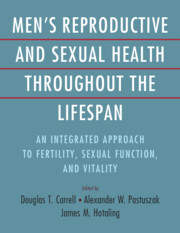 Men's Reproductive and Sexual Health Throughout the Lifespan
Men's Reproductive and Sexual Health Throughout the Lifespan from Section 2 - The Biology of Male Reproduction and Infertility
Published online by Cambridge University Press: 06 December 2023
The definition of epigenetics has been redefined in the last decades and today is generally accepted as the study of heritable factors, other than DNA base pair coding, that regulate gene expression. In this chapter, we briefly review the main epigenetic factors that exist in spermatozoa (e.g., histone and chromatin modifications, DNA methylation, and noncoding RNAs [ncRNAs]) and underline the associations and effects of aging, adiposity, and some lifestyle and environmental factors on the sperm epigenome. In conclusion, further work needs to be done to establish whether the changes of sperm epigenome triggered by aging, adiposity, diet, and smoking can have not only implications for the reproductive health but also for the future offspring.
To save this book to your Kindle, first ensure no-reply@cambridge.org is added to your Approved Personal Document E-mail List under your Personal Document Settings on the Manage Your Content and Devices page of your Amazon account. Then enter the ‘name’ part of your Kindle email address below. Find out more about saving to your Kindle.
Note you can select to save to either the @free.kindle.com or @kindle.com variations. ‘@free.kindle.com’ emails are free but can only be saved to your device when it is connected to wi-fi. ‘@kindle.com’ emails can be delivered even when you are not connected to wi-fi, but note that service fees apply.
Find out more about the Kindle Personal Document Service.
To save content items to your account, please confirm that you agree to abide by our usage policies. If this is the first time you use this feature, you will be asked to authorise Cambridge Core to connect with your account. Find out more about saving content to Dropbox.
To save content items to your account, please confirm that you agree to abide by our usage policies. If this is the first time you use this feature, you will be asked to authorise Cambridge Core to connect with your account. Find out more about saving content to Google Drive.